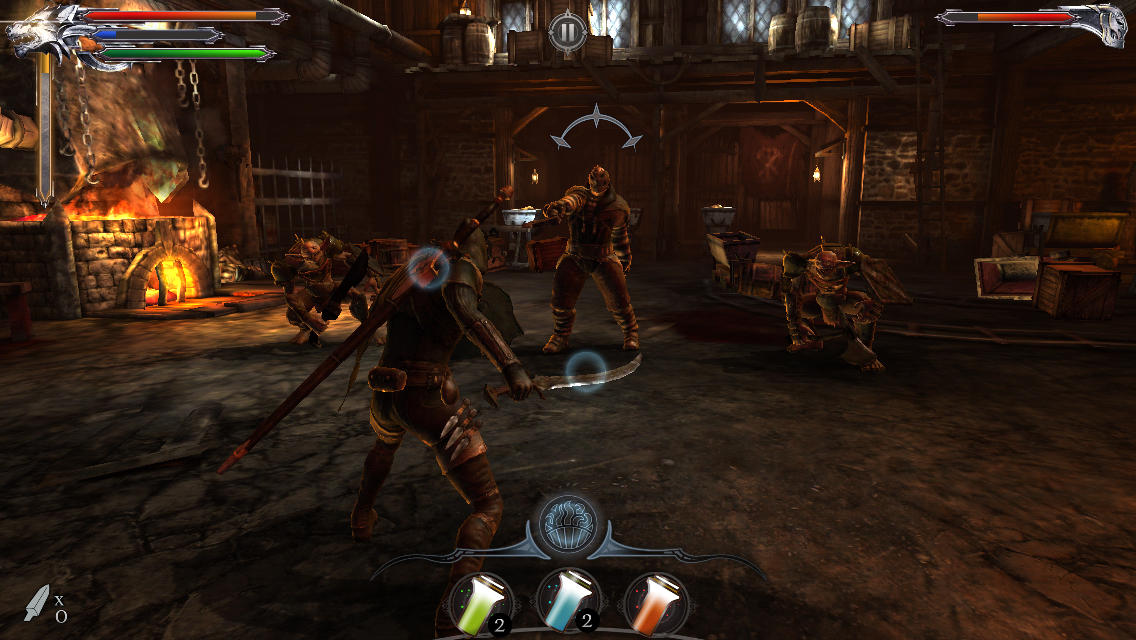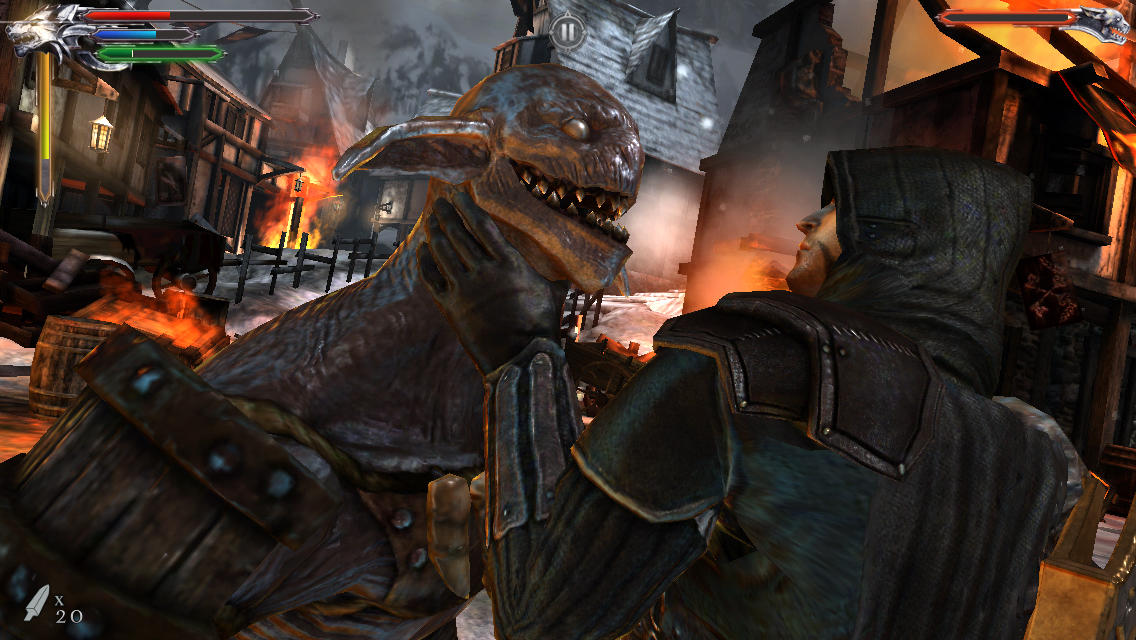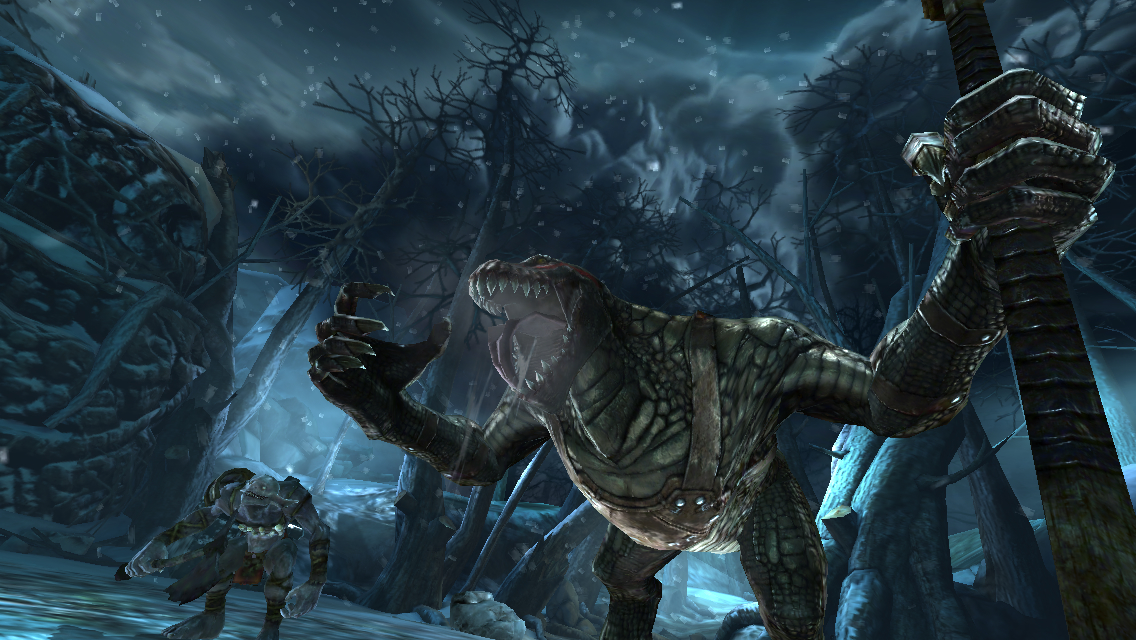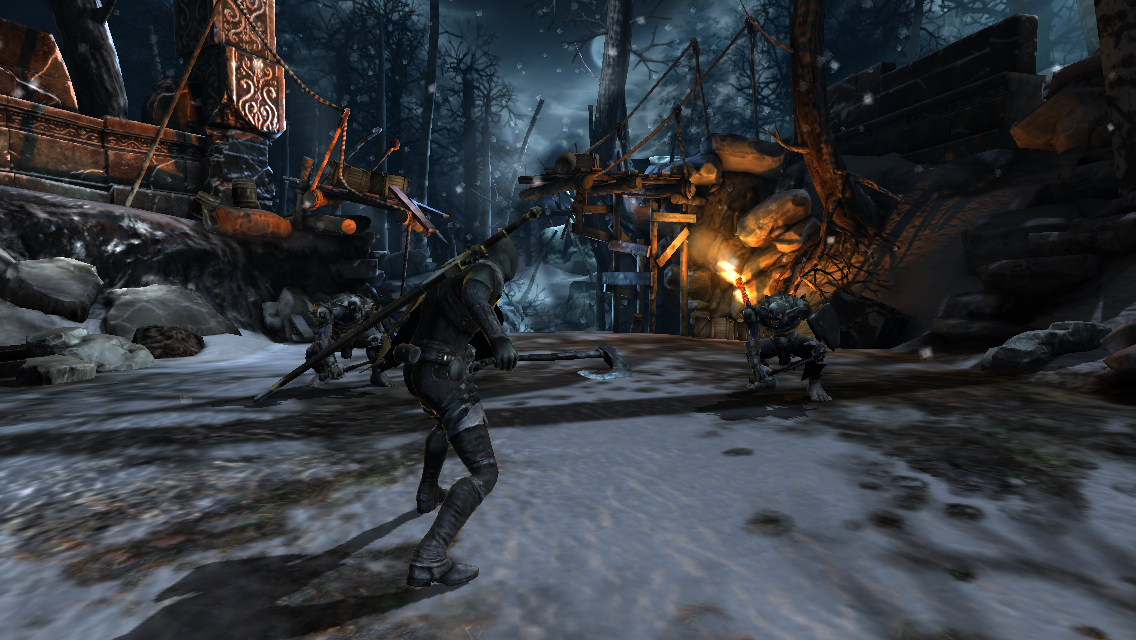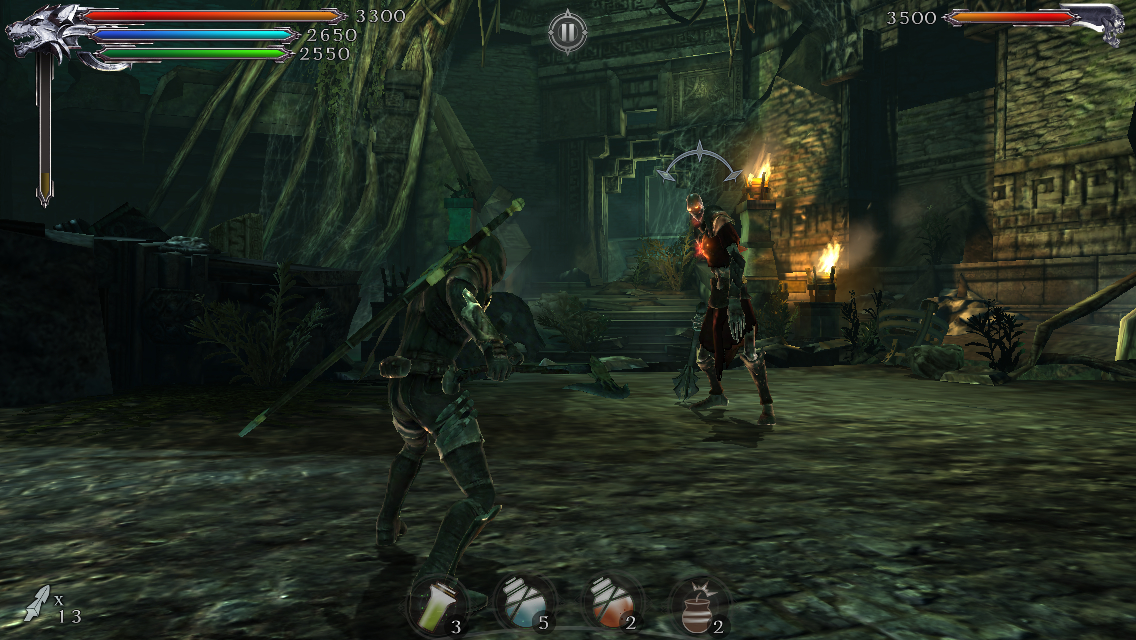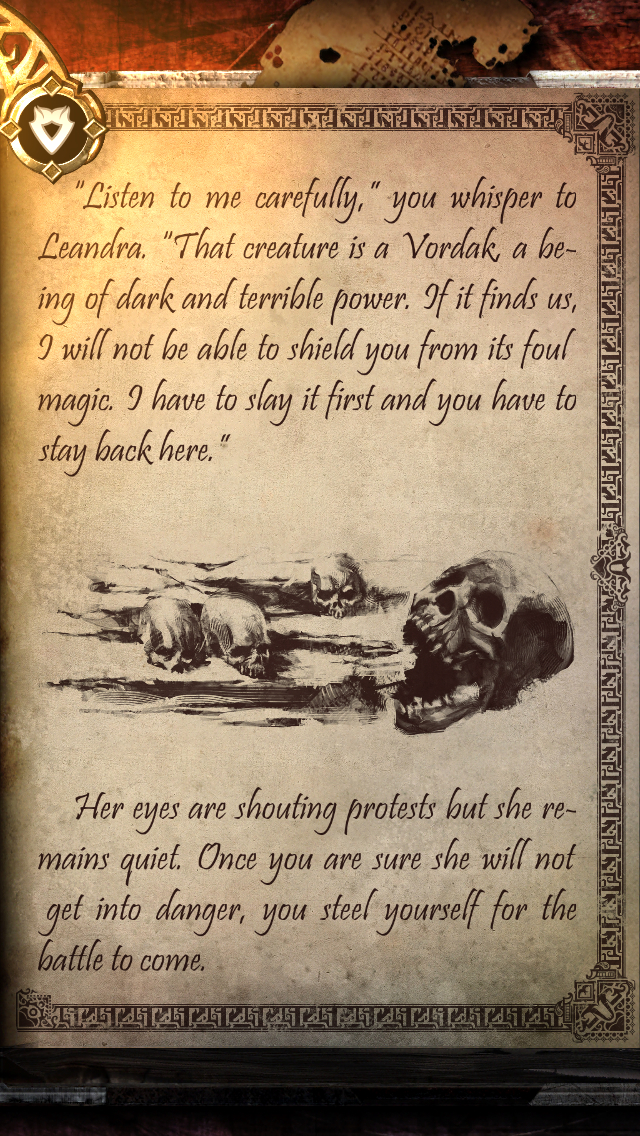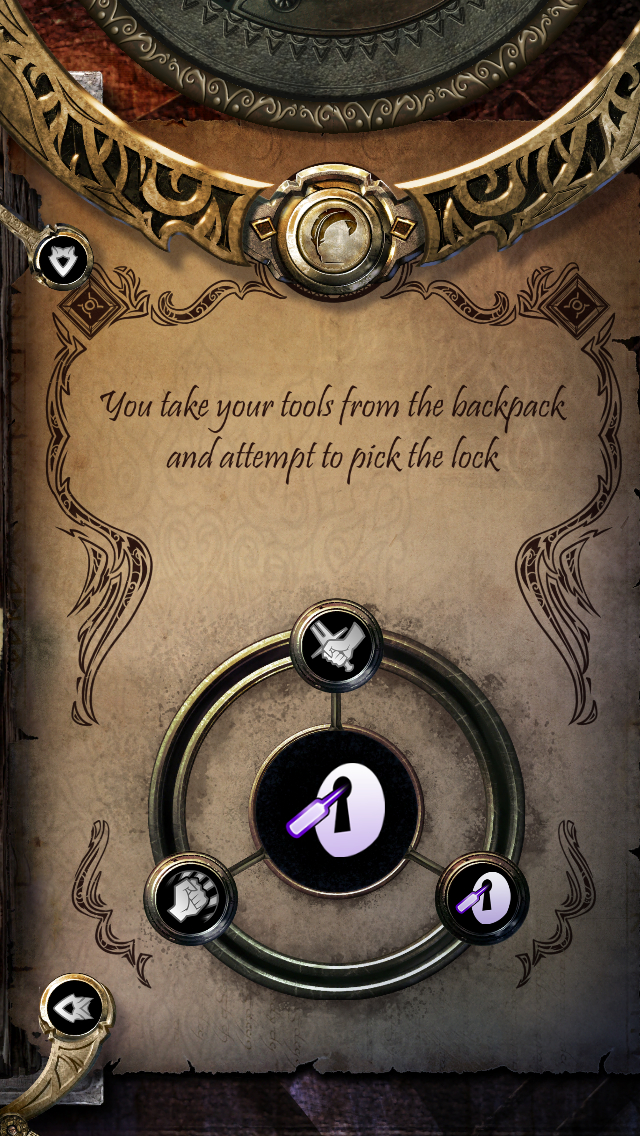![]() Even if you’ve never heard of the Lone Wolf series of gamebooks written by Joe Dever (with their sporadic publishing history I wouldn’t blame you), Joe Dever’s Lone Wolf (Free), a new adventure made specifically for mobile platforms, has got a lot of initial punch. While everything seems to start like any other gamebook you’ve played on iOS, as soon as you reach the first battle of the game, it’s clear that this game has got some strong ideas about where to take gamebooks in the future. The ‘Wow’ factor of turning the page to an illustration that comes to life in full 3D can’t be underestimated, but in its quest to escape the shackles of its old format, Lone Wolf trips over some very familiar problems inherent to its new one. In the style of our reviews of The Walking Dead (Free) and The Wolf Among Us (Free), this review will be appended to as each new act releases.
Even if you’ve never heard of the Lone Wolf series of gamebooks written by Joe Dever (with their sporadic publishing history I wouldn’t blame you), Joe Dever’s Lone Wolf (Free), a new adventure made specifically for mobile platforms, has got a lot of initial punch. While everything seems to start like any other gamebook you’ve played on iOS, as soon as you reach the first battle of the game, it’s clear that this game has got some strong ideas about where to take gamebooks in the future. The ‘Wow’ factor of turning the page to an illustration that comes to life in full 3D can’t be underestimated, but in its quest to escape the shackles of its old format, Lone Wolf trips over some very familiar problems inherent to its new one. In the style of our reviews of The Walking Dead (Free) and The Wolf Among Us (Free), this review will be appended to as each new act releases.
Act 1: Blood On The Snow
Our protagonist is the titular Lone Wolf, a powerful warrior monk with a tragic past. Rockstarn, a small, snowy mining town has gone quiet, and you have to find out what’s happened. Spoiler: tragedy! This is the first of four acts. The remaining acts will be available within this app as IAP as they are finished, and at the moment you can purchase a season pass for $9.99, with the individual acts priced at $4.99. This act, being the first one, is pretty light on story, quite linear, and has very little in the way of plot resolution. This shouldn’t be a problem, provided the remaining acts actually move things along, but taken on its own, it feels a bit anemic.
In most respects, this game is like other gamebooks you may or may not have played. You begin by creating your character, and there’s quite a bit of customization present here thanks to a hefty list of skills to choose from. You can also choose your starting weapon, and whether you lean more towards strength, intelligence, or dexterity, which affects your starting stats. You’ll begin with a small assortment of items, including a few potions for restoring your health, kai power (magic), and endurance, some throwing knives, and a couple of food items you can use outside of battle to replenish your meters. From here it proceeds like a book, of course, with the story being told through text with the occasional picture. At certain points you can choose from a few different actions, with your skill choices and inventory determining exactly what you’ll be selecting from. Sometimes, you’ll run into monsters, and that’s when things get a little different.
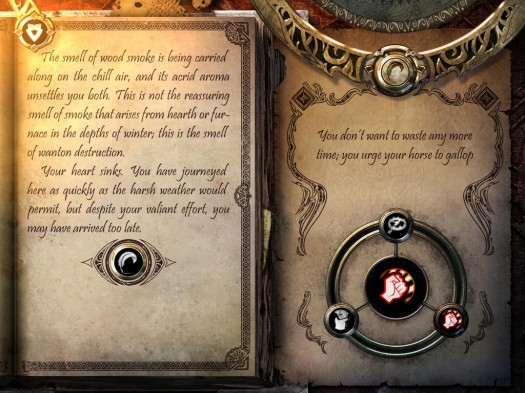 Most gamebooks to date handle combat with virtual dice, a tried and true method that is basically behind the hood of most RPGs, paper or digital. Rolls are made against your stats and the monster’s, and the book tells you the outcome. Lone Wolf, on the other hand, seems to ask, “Can we make those action bits a bit more action-like?" So, when a battle starts, you’ll have to turn your device on its side, and the monochrome inked illustration will suddenly come to life in full color, in a somewhat unique battle system. On the surface, it feels like Final Fantasy‘s Active Time Battle system, where each combatant has a meter filling up that determines when they can take their turn, meaning enemies can hammer on you if you take too long to decide what to do. There are quite a lot of available options once your turn comes up, but between your kai and endurance meters and cooldown timers on almost everything, you’re going to run into your limits fairly often, so you’ll want to choose your actions on each turn very carefully.
Most gamebooks to date handle combat with virtual dice, a tried and true method that is basically behind the hood of most RPGs, paper or digital. Rolls are made against your stats and the monster’s, and the book tells you the outcome. Lone Wolf, on the other hand, seems to ask, “Can we make those action bits a bit more action-like?" So, when a battle starts, you’ll have to turn your device on its side, and the monochrome inked illustration will suddenly come to life in full color, in a somewhat unique battle system. On the surface, it feels like Final Fantasy‘s Active Time Battle system, where each combatant has a meter filling up that determines when they can take their turn, meaning enemies can hammer on you if you take too long to decide what to do. There are quite a lot of available options once your turn comes up, but between your kai and endurance meters and cooldown timers on almost everything, you’re going to run into your limits fairly often, so you’ll want to choose your actions on each turn very carefully.
Whatever you choose, there’s a high chance that you’ll have to perform a QTE to complete the action. These run the usual gamut of tapping to fill a meter, tapping with the right timing, swiping in a particular direction, or making a circle. These QTEs are consistent with each action, so once you learn them, you won’t be blindsided by them. I can’t say the same for the enemy attacks, which will sometimes result in a QTE and sometimes nothing at all. Stay on your toes when the enemy is attacking, even though most of the time you’ll be powerless to avoid damage. You’re going to take a lot of beatings in this game, which is pretty odd given the relative power difference of Lone Wolf and these enemies according to canon. It’s like Superman getting taken out by a mugger.
If I had to name a single problem with this game that really hurts it, it’s the difficulty. Lone Wolf comes out swinging hard, right from the first fight. There’s a tutorial but the game doesn’t really give you a chance to get comfortable with how battles work before putting you in very real danger, a situation only exacerbated by the QTE-heavy combat. As I said before, the QTEs are consistent, so you will easily learn what to do in time, but the first couple of battles depend on your fast reactions, and the window of success is somewhat small. This creates a frankly bizarre scenario wherein the first two fights are probably the second- and third-hardest fights of the entire act, and I’d bet most people are going to eat dirt hard on their first go. Should you fall in battle, you have a few options, including a direct rematch, rewinding back to just before the battle, or restarting the battle on easier difficulty, so it’s not like the game has no bones to offer you. It’s just that it’s a bit unforgiving by default and has more of a difficulty valley than a difficulty curve.
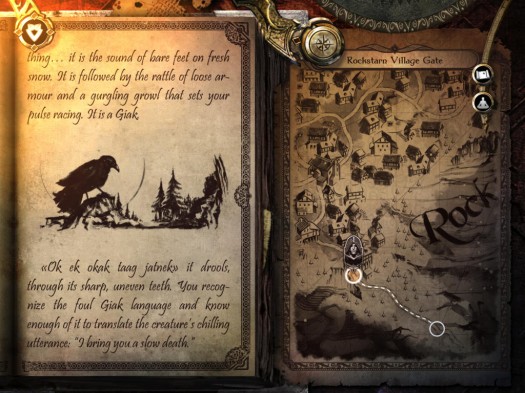 As for the most difficult fight in the game, it is fittingly the final one, but wow, is it all kinds of cheap. I openly confess that in spite of several attempts, I could not make it through without taking the game’s mercy and switching to the lower difficulty. The boss stun locks you right off the hop, and I suspect unless you have a very particular build of stats, you’re going to run into the same results I did: death, every time, without so much as the chance to take a turn. I’m sure it’s doable with the right character build and equipment, but as you can’t respec, I imagine the boss is going to prove to be quite the brick wall for most. Thankfully, that option to choose the lower difficulty is there, or I’d be a whole lot more annoyed.
As for the most difficult fight in the game, it is fittingly the final one, but wow, is it all kinds of cheap. I openly confess that in spite of several attempts, I could not make it through without taking the game’s mercy and switching to the lower difficulty. The boss stun locks you right off the hop, and I suspect unless you have a very particular build of stats, you’re going to run into the same results I did: death, every time, without so much as the chance to take a turn. I’m sure it’s doable with the right character build and equipment, but as you can’t respec, I imagine the boss is going to prove to be quite the brick wall for most. Thankfully, that option to choose the lower difficulty is there, or I’d be a whole lot more annoyed.
The other big problem with Lone Wolf is that it comes off feeling like a demo or a prologue due to a general lack of content. There are only a few types of enemies in the whole thing, and you’ll be facing half of them often enough to get tired of them. There also aren’t very many battle backgrounds, leading to odd but tolerable narrative disconnects. It’s quite a short adventure, with relatively few places to go and choices to make, and the whole thing wraps up in a few hours. That’s not terrible for a gamebook, but this game has a lot less replay value than the average gamebook thanks to the aforementioned linearity. You’ve got a few seemingly-important choices to make, but we don’t see any real consequences for any of them.
To top it all off, not much really happens. The whole adventure takes place in the town, and only a few buildings at that, and amounts to what would be a fetch sidequest in most games. I know, it’s just the first act, but good episodic storytelling requires each one to tell a satisfying story within the larger narrative, and Lone Wolf fails at that. It’s all set-up and no go. The set-up is exhaustive, I’ll give it that, but the breadth of the gameplay balanced against the length of the story causes it to feel like I’ve just played through a tiny sliver that was mercilessly sliced off a larger game with little regard for where it was cutting. For example, there’s a seemingly robust crafting and upgrade system, but you’ll probably reach the end of the game before you can gather the items to make much use of it. Of course, once the remaining acts hit, your character will carry through, allowing for greater exploration of these systems, but I can only review what’s in front of me today, and what’s here gives all the satisfaction of going into a steakhouse, taking a lick of a delicious porterhouse, and walking out.
The nice thing about the problems I’ve talked about here is that they’re all fixable, and I’m sure we’re going to see better results with the remaining chapters. Lone Wolf has got my attention and I definitely want to see more, because I love what they’ve set up here in terms of gameplay. I’m genuinely excited to see these interesting new concepts come to a genre that has mostly hung its hat on intentional nostalgia, but while the ideas are exciting, the execution of this particular act isn’t, I’m afraid. No other gamebook will give you what Lone Wolf does gameplay-wise, but Lone Wolf won’t give you what any other gamebook will give you content-wise, and that makes it a bit of a hard sell at the moment, in my opinion.
Act 2: Forest Hunt
The second act of Lone Wolf has finally arrived, and between it and the patches delivered after my review of the first act, many of my problems have been addressed. The difficulty has been adjusted, with new settings added. There are more types of enemies and a wider variety of backgrounds for battles. In terms of story progression, an awful lot happens here, including revealing what seems to be the main plot. There are quite a few more places to visit, and this act is lengthy enough that you’ll surely need to take advantage of the crafting system, giving use to the odds and ends you collected in the first act. All of the engine changes, such as enemies having the ability to use projectiles, have been retroactively applied to the first act, ostensibly making for a better experience from the get-go.
Lone Wolf and Leandra have escaped the devasted town of Rockstarn using the elevator and must now try to locate the missing townspeople. Few, if any, answers have been given about why the monsters have invaded Rockstarn and how they went about doing it so thoroughly. Forest Hunt answers virtually all the questions raised in Blood On The Snow, while raising a few new ones. This act is a lot longer than the first, both in terms of playtime and in terms of how meaty it feels. I feel like I have a solid grasp on what Lone Wolf actually is as a full game, rather than as a tasty little proof of concept. In the process, some prior misconceptions I held have been cleared up. Most notably, I don’t think it’s useful to look at this as a gamebook. There’s certainly a fair bit of reading and page-turning here, and it has the superficial trappings of a gamebook, but Lone Wolf is an RPG, first and foremost.
I say this because I feel that gamebooks are usually about choices. Those choices, for better or worse, matter quite a lot to your outcome. In fact, any other systems in gamebooks, such as combat, usually exist to serve those choices. Lone Wolf offers choices, but they’re generally of little consequence to the narrative itself. Rather, what you do usually results in some kind of changed situation in your next battle, such as the enemies being inflicted with a status effect. Like the first act, there are a couple of narrative choices in Forest Hunt, but they’re few and far between. Lone Wolf is not about making the right choices. It isn’t even really about exploring or anything like that. Lone Wolf is about combat, and lots of it.
With the clarity that comes with familiarity, it’s easy to see that. It’s not that there isn’t anything else, mind you. There are, eventually, optional areas on the map, and you will sometimes have to solve a puzzle to open a door, but it always comes back to combat. That’s extremely apparent in the first half of this act, which could generously be described as a fight tunnel. A tunnel of hate, if you will. You read a page, you have a fight. You read another couple of pages, you have another fight. There are no branches, there are no real choices, and certainly no choices that will avoid a fight. You simply fight and then move on to the next fight. This doesn’t have to make for a bad time, but it can, simply because Lone Wolf‘s combat just isn’t that good.
I’ve got a much firmer grasp on it now that I’ve played through the whole thing a few times, and while there’s certainly a strategy to it, that strategy never really changes from battle to battle. Sometimes you’ll be facing more dangerous enemies with stronger attacks and more hit points, but that doesn’t change what you’ll be doing. Check your hit points, if they’re low, heal, if not, take a swing at an enemy. If the enemy’s low on HP, toss some knives or fire some crossbow bolts to finish them off. If not, use your shield to recover endurance and reverse attacks. Use your big sword attacks when they’re charged, and watch for QTEs. This all works the same whether you’re facing a group of the weakest mooks or the boss of the act. Sure, sometimes luck won’t be in your favor, and you’ll get pounded from full HP to zero before you can even act, but if that happens, you can just restart the battle and hope for better fortune.
As I mentioned, this act answers a lot of questions, probably too many, in fact. I’m happy we get a fair bit of resolution, since the first act offered almost none, but the narrative finds itself in a position where it has to refocus the story, and the new direction is a lot more hokey and uninteresting than the original one. I didn’t find the text to be very compelling at all, which I think resulted in the emphasis being further placed on the creaky combat. I do welcome the new puzzles that show up in the later part of this act. It was refreshing to do something other than input QTEs and run my battle script. Hopefully, we’ll see more of this kind of variety in the final two acts of the game.
Forest Hunt is missing some of the surprise value of Blood On The Snow, but it’s all-around a more competent experience, and the changes made show awareness of the game’s faults. That’s why, even though I haven’t particularly enjoyed Lone Wolf to the fullest extent as of yet, I’m still remaining optimistic about how it’s going to end up. It’s also very safe to say that if you enjoyed the first act, you should go ahead and pick up the second act without worry.
Act 3: The Shianti Halls
Well, we’re heading into the home stretch now on Joe Dever’s Lone Wolf, and before I dig into the particulars of this episode too deeply, I want to highlight how much this game has improved mechanically from when I wrote about the first episode all those months ago. I can’t imagine it was easy to go in and make fairly major changes all while trying to put together the next episode. The difficulty has found a nice balance, the combat offers considerably more options than it once did, and there’s a decent variety of enemies to battle with. The frequent QTEs are a lot less strict than they used to be, and there are even puzzles here and there to break things up. On top of that, now that the game is stretching its legs out a bit, the crafting system and character progression are yielding increasingly better fruits. I still think this game has some fundamental problems, but thinking about where things started and where we are now, I think this is undeniably a better experience than it once was.
The Shianti Halls is a more focused act than Forest Hunt was. While that act had a couple of different areas, this act takes after the first one, with just a single setting to navigate and explore. I’m using the word ‘explore’ loosely here, because apart from one point where you can choose between a few different places to go next, you’re mostly on a straight path from start to finish. Yet, somehow, The Shianti Halls feels a lot more satisfying than the prior acts. It’s an adventure that feels both well-paced and substantial, and while the end of the game obviously has a cliffhanger to carry us into the final act, it still feels like Lone Wolf got things done this time around. It’s a welcome change from the lack of payoff in the first act and what felt like a story reboot in the second act. The story here even manages to do a decent job of stitching those two together, though things seem to be proceeding in a disappointingly obvious direction at the close of Shianti Halls.
You’ll finally have access to Lone Wolf’s full range of powers in this act, and the combat has been refined to make dual-wielding a lot more viable. I still felt like the shield was a better choice, but if you want to go all Miyamoto Musashi on the enemy, it’s at least a worthwhile option now. My only complaint about the combat itself is that it’s starting to get a little too easy. With all the items, gear, and abilities you’ve surely gathered up by now, even the strong enemies and act boss are a bit trivial. I’m not going to complain about this too much, though, since putting together the right chain of moves to take down enemies before they can even touch you feels good in a medieval Batman sort of way. I lost more times to the game crashing than to an enemy killing me. The current version dislikes it when you combine throwing daggers with the new enemy type.
There are more of the cube manipulation puzzles that were introduced in the last act, and while they’re nice, I would appreciate it if there were more types of puzzles here and there. It’s also still very irritating at times trying to rotate the cube around to the angle it needs to be at to pass the puzzle. Nevertheless, they’re a welcome break from the near-constant combat. The way virtually any choice the game gives you inevitably leads to a fight is nearly approaching self-parody at this point. No matter which skills you have or which approach you try to take, Lone Wolf will somehow bumble things and end up in direct combat. I’m glad I started over with a non-stealth build, because it was becoming laughably frustrating how ineffective that particular skillset was proving to be. To the game’s credit, it plays around more with status effects to try to mix up the battles a little bit. It doesn’t make a huge difference, but I can acknowledge the effort.
I was pretty satisfied with the story in this one. It’s nothing exciting, but it kept my interest and poked me for a few narrative decisions that, whether illusion or not, felt like they had an impact on my quest. I can’t be too sure, but I think some of the decisions from previous acts, largely connected to your relationship with Leandra, even came home to roost in The Shianti Halls. I also like how the narrative choices slyly force you to choose between your principles and practicality. It doesn’t come off as forced or obvious, and even after finishing the whole thing, I’m not entirely sure if the choices I made were the right ones. It shows a solid improvement in both the plotting and the actual writing quality. This is the level of quality I was hoping for from the very first act, but I’ll take late over never any day of the week.
All told, I don’t think Lone Wolf is going to end up with a particularly great overarching plot, but I’m okay with a few loosely-connected stories as long as they’re interesting enough on their own, like The Shianti Halls proves to be. I hope the team continues to iron out pacing issues, because although I feel like this third act has the best tempo to it, the back-to-back fights still get a bit tiresome at times. I think the cube puzzles are pretty well played out now, so I hope Forge Reply has another trick up their sleeve to shake things up a little in the fourth and final act. All that said, I’m glad to see Lone Wolf is finally starting to reach the potential I had hoped it had. Here’s hoping the developers can nail the conclusion.
Act 4: Dawn Over V’Taag
Now, with Dawn Over V’Taag released, the year-long journey of Lone Wolf has come to a close, at least for the time being. I wish I could tell you he’s going out with a bang, but he’s not. Thankfully, he’s also not going out with a whimper. He’s just sort of picking his keys up off the table and giving you a silent nod on his way out the door. Dawn Over V’Taag, in many ways, carries with it the best and the worst of each act thus far. It’s probably the most relentless combat tunnel since the first section of Forest Hunt. There are only a couple of chances to go off the linear path to the end, and even those are just there to offer some extra goodies before setting you back on the main road. There are a few cube puzzles to break up the seemingly never-ending sequence of fights, but they’re so rote by now it’s hard to muster interest in them. Your choices are just as laughably meaningless as they were in The Shianti Halls. As I had feared, the completed story is quite weak, a contrived RPG plot fluffed up with a lot of fantasy tropes. In the end, Joe Dever’s Lone Wolf heavily depends on the very thing that enabled it to catch eyes in the first place: the combat.
If you had told me that when I first started reviewing this game, I would have been filled with dread, because the combat was very rough in those early days. In the here and now, I’m actually okay with that. Lone Wolf has reached the point where it has a sufficiently large pool of enemies, status effects, and combat options to set up some genuinely good battles. I’m not saying every battle is great, as some enemies are just punching bags that waste your time, but most of them at least require a bit of strategy. The enemies have a wide array of status ailments they can inflict on you, applying pressure or restricting your options in some way, so you have to really think about the order in which you defeat them. The story itself sometimes takes away things you may have come to rely on, forcing you to find new tactics to win. The game manages to offer a decent challenge without falling back into the frustrating tactics used in the launch version, and the QTEs have been tamed into something downright tolerable. The boss fights are particular standouts this time around, although one of them unfortunately repeats often enough to drain it of its considerable initial novelty.
That’s kind of a problem with this act in particular, and one of my main criticisms of the game on the whole. It has plenty of good ideas that will thrill you the first time you run into them, but by the time the dawn has come, you’ll have had them thrown at you so often that all of sense of wonder is gone. By the time I reached the end of the adventure, I was almost as tired as our unfortunate protagonist was of the whole affair. You almost have to take the game in chunks to avoid getting burnt out by the incessant combat with little of value in between. It doesn’t help that the heavy amount of text used to tell the story is handcuffed by the need to constantly set up battles, never having the chance to truly develop any sort of narrative flow. Lone Wolf just stumbles from fight to fight, his every action somehow alerting the enemy to his presence. It reminds me of the old Simpsons gag where Sideshow Bob is in the parking lot full of rakes. You can’t tell much of a story in that kind of context.
In the end, I’m still really conflicted about Joe Dever’s Lone Wolf. It doesn’t have a lot to offer gamebook fans looking for similar thrills they found in the old dead tree versions, nor is it open or varied enough to completely satisfy RPG fans. As a cohesive story, it’s kind of a bust, but as a day in the life of Lone Wolf, it’s a pretty fun and action-packed series of events. It’s a fascinating experiment, occasionally a beautiful little piece of art, and I really ended up enjoying both the combat system and the character building in the long run. It is without question a mixed bag, but it’s such a unique experience that I think it’s worth persisting through its rough spots to enjoy the things that it does well. I liked the game well enough that I would love to see Lone Wolf return in this format someday, even though I can’t say I had a great time the whole way through. If you have an appreciation for quirky games, you’ll probably find yourself feeling the same way.
